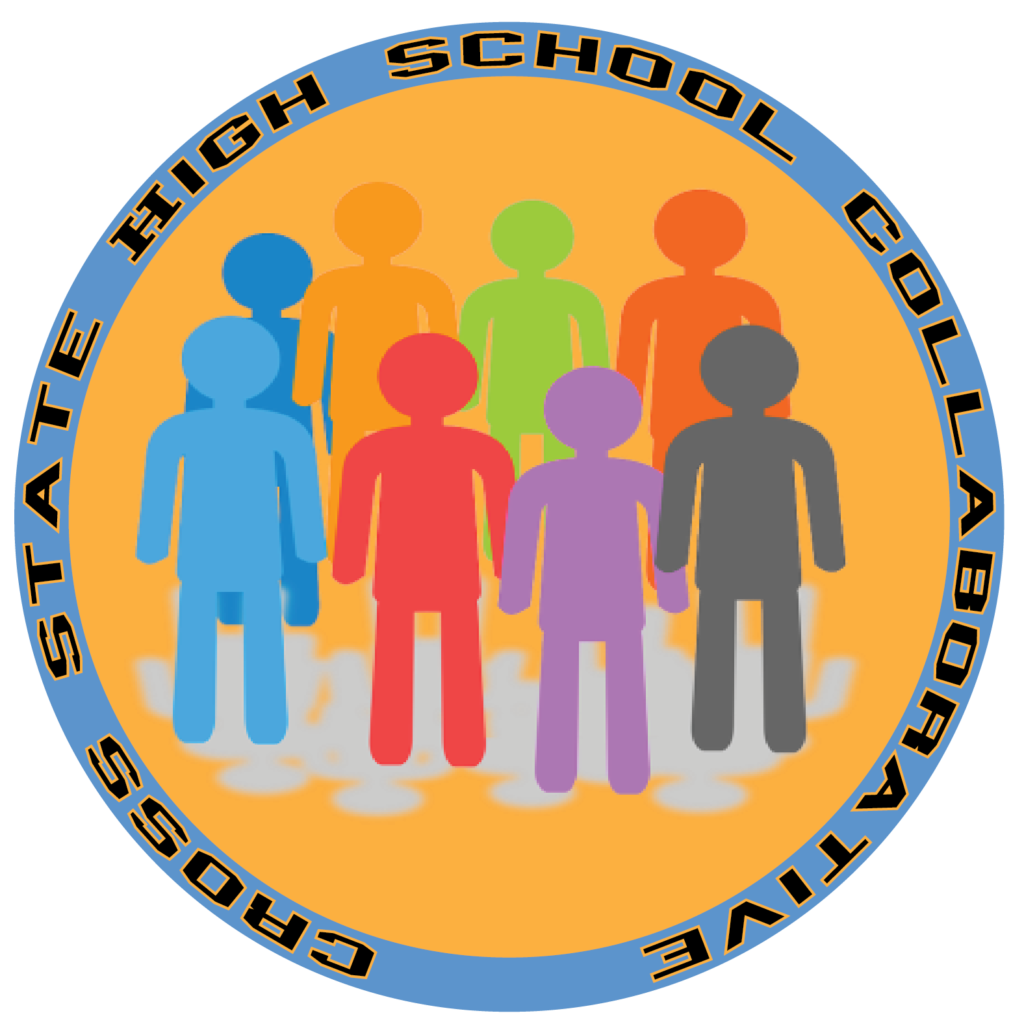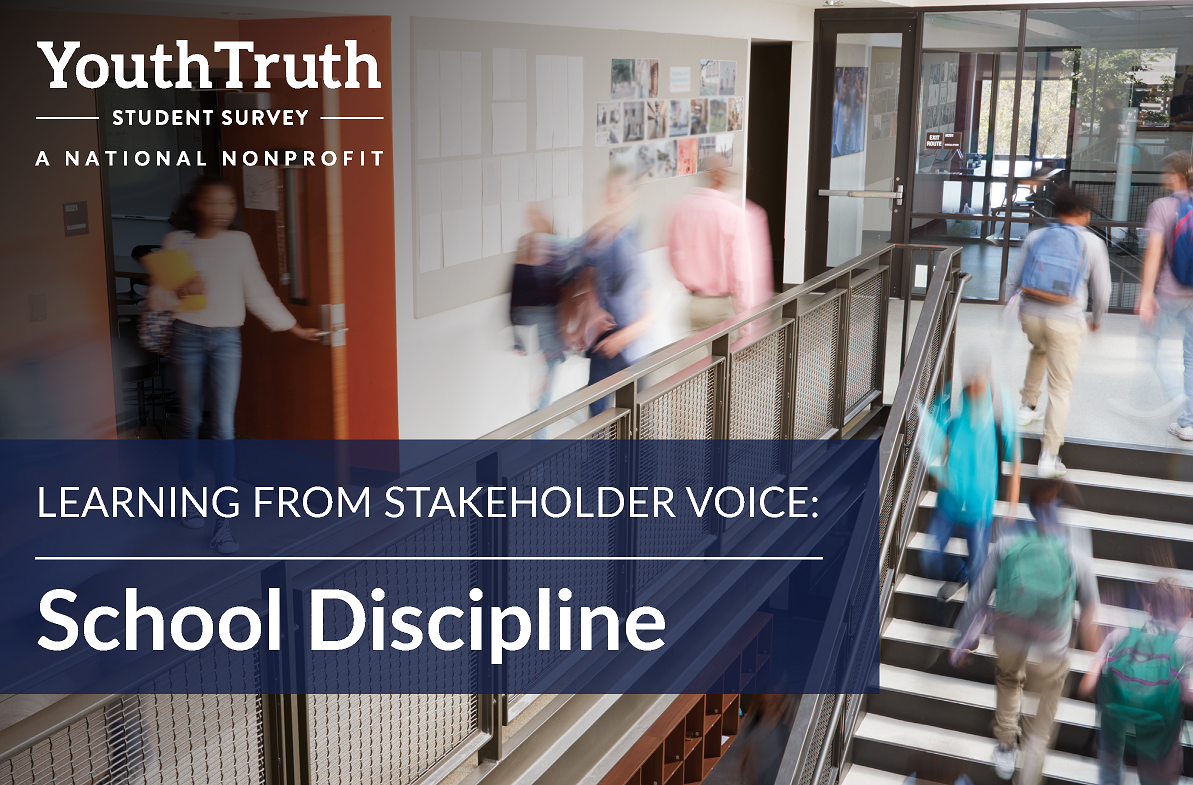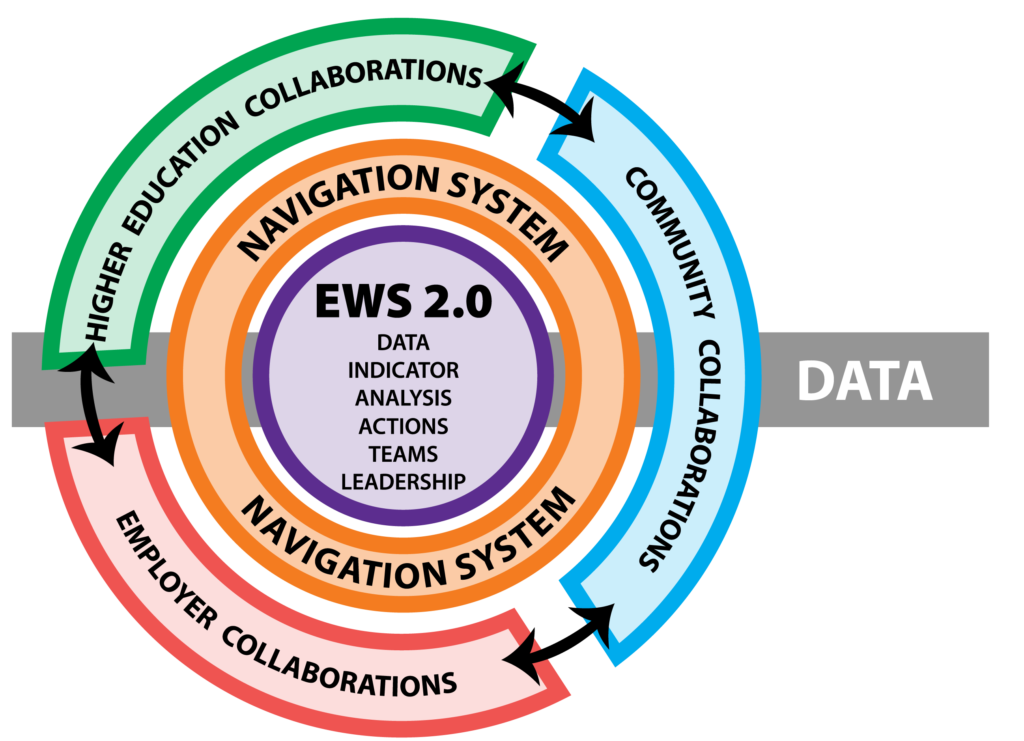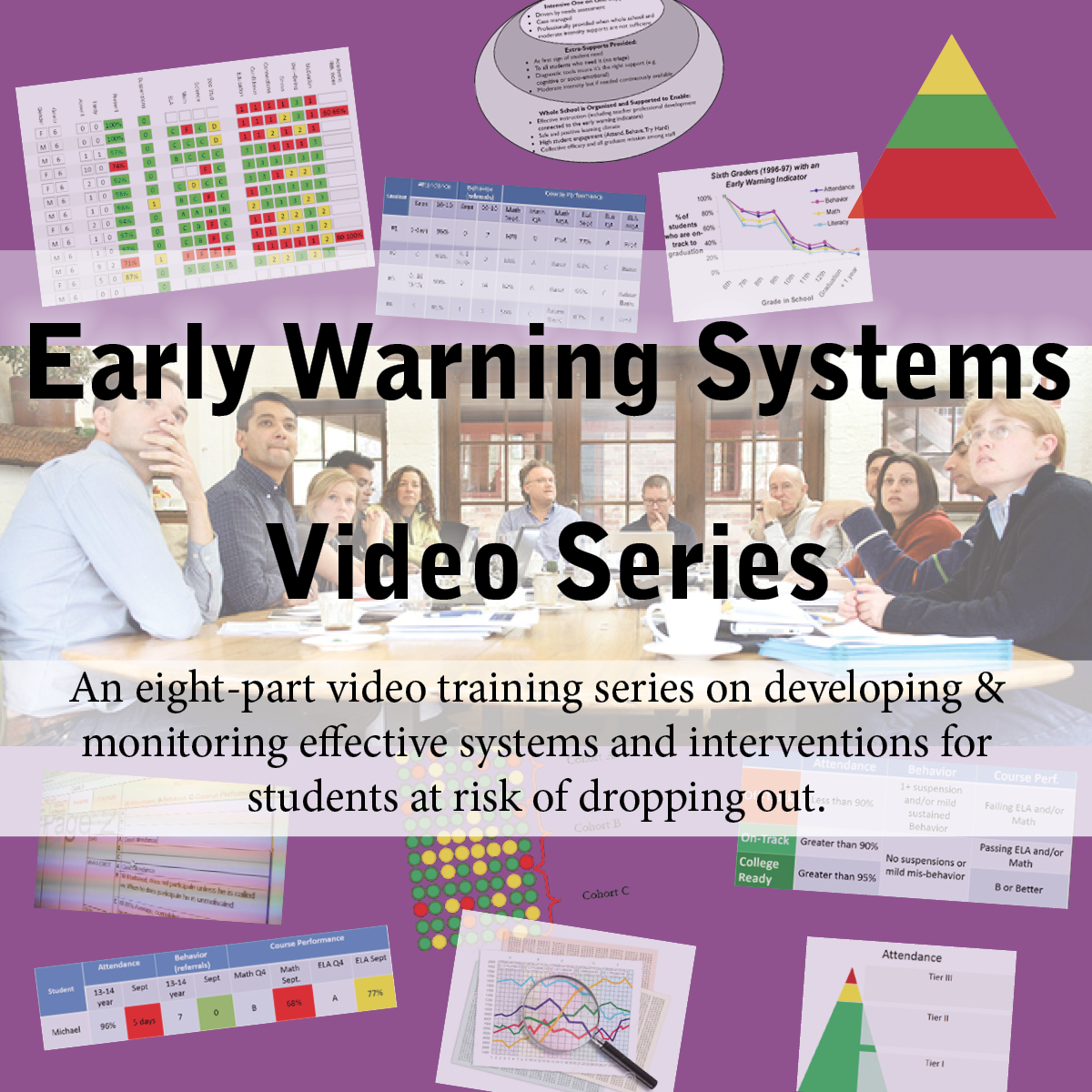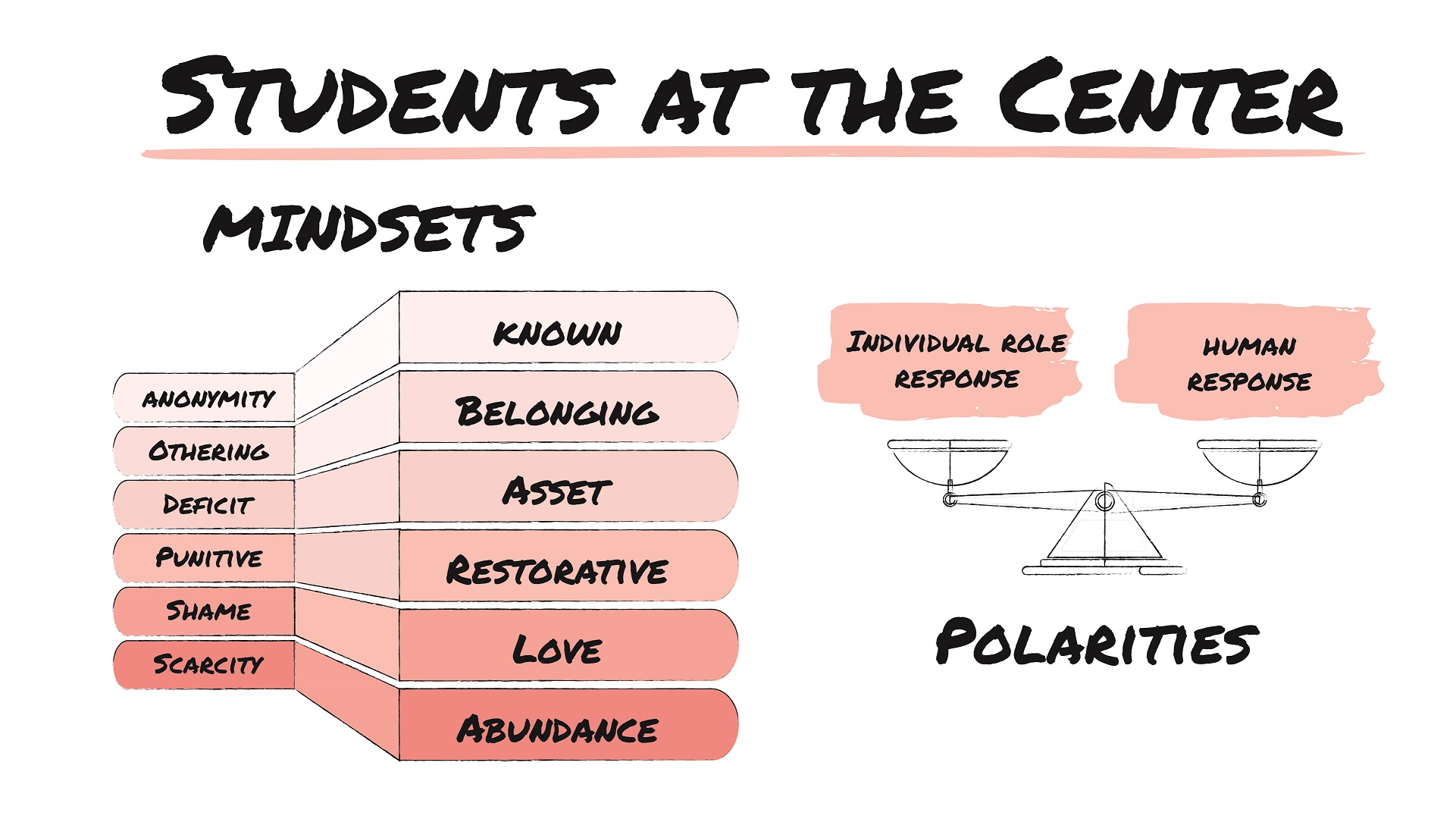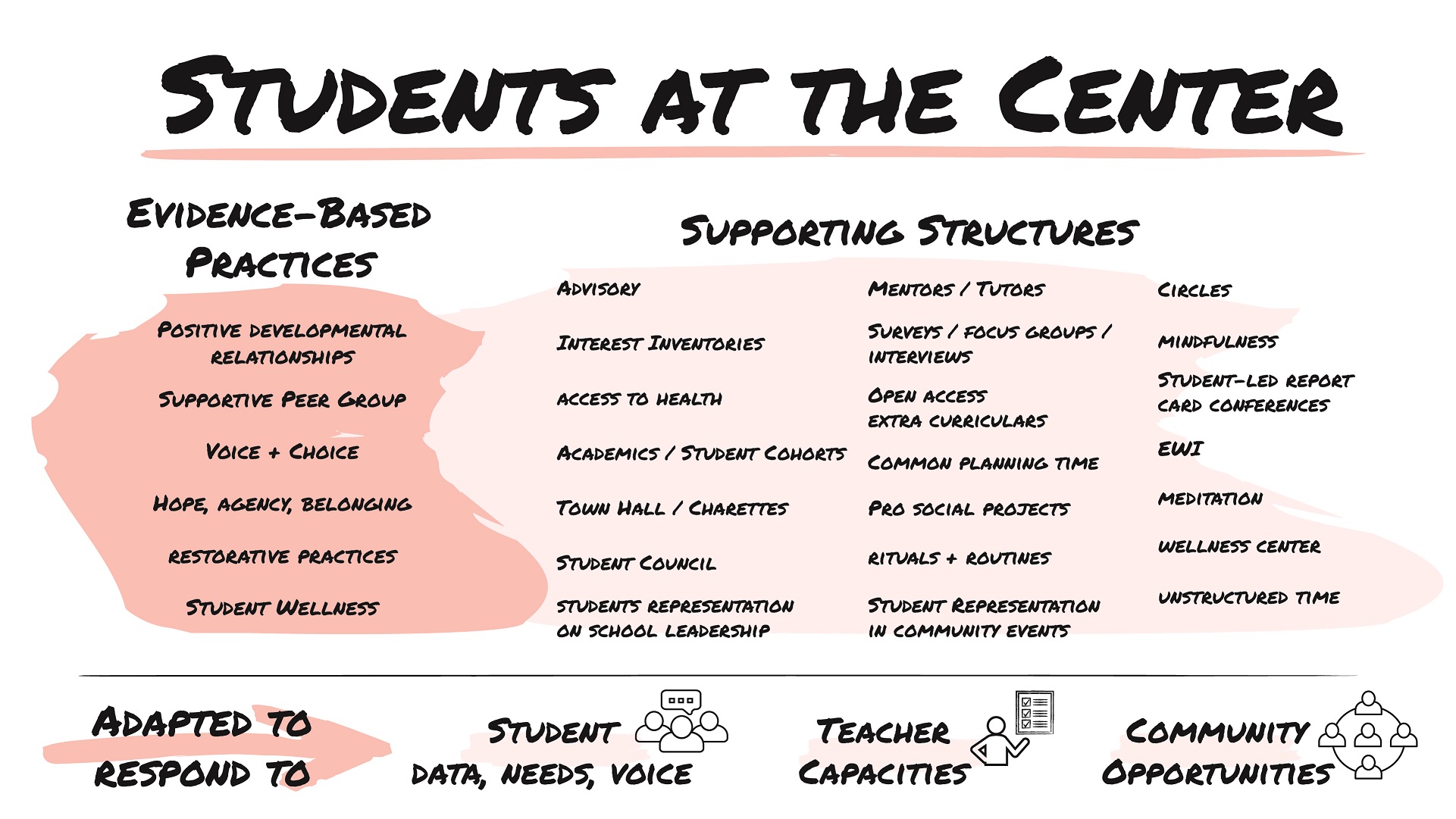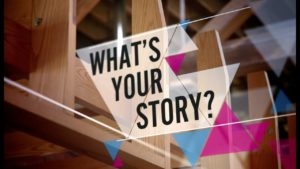Students at the Center
As teams begin to consider redesign, it’s important to integrate how to keep students at the center of their educational experiences into their design thinking. Student apathy, lack of motivation, and non-productive behaviors are some of the factors which limit learning and underlie teacher stress and burnout. The longer students are in school, the less hopeful they become regarding their educational experiences. This often results in higher rates of student and teacher absenteeism, higher rates of student suspension, and less learning ultimately.
Placing students at the center of redesign helps align students’ interest with teachers and administrators desired outcomes.
What the Evidence Says
These resources are summaries and synthesis of the evidence base for high school improvement. Also included are significant individual studies on key redesign and improvement practices.
Building Positive Developmental Relationships
- How important was your favorite teacher to your success? Researchers have done the math Recent study shows power of adult-student relationship in school, and why creating spaces for connection to happen is important. Learn more
- Belonging: The Science of Creating Connection and Bridging Divides Self-reflection on important personal values, such as relationships with friends and family or musical interests increases achievement due to enhanced knowing of belonging and connectedness. Then want to learn more?
- Mindsets and the Learning Environment: Understanding the Impact of “Psychologically Wise” Classroom Practices on Student Achievement An ideal learning environment develops students’ feelings of competence, connectedness, and purpose. When these conditions are met, students are more likely to choose challenging tasks, persist in the face of difficulty, learn more deeply, and achieve at higher levels. Download the PDF
- The Relationship Among Classroom Growth Mindset Climate, Trust and Respect, and Student Performance in Mathematics This study examines how growth mindset classroom climates – defined as students’ shared perception that the teacher believes that all students can master the class material using hard work, effective learning strategies, and asking for help when needed – shape students’ academic experiences and performance. Download the PDF
- Mindsets and the Learning Environment: Evidence from Half a Million Students on the Importance of Belonging in Schools Students This study examines how self-reported sense of belonging in school is related to gains in a range of student test and non-test outcomes. Download the PDF
- What We Know About Belonging from Scientific Research Students with a sense of belonging in school feel socially connected, supported, and respected. They trust their teachers and their peers, and they feel a sense of fit at school. They are not worried about being treated as a stereotype and are confident that they are seen as a person of value. Download the PDF
- Framework for Transformational Change Knowledge from educational practice and research together clearly points towards a whole-child purpose as the driving force of school transformation, which is actualized through a set of systems, structures and practices that promote a supportive environment, developmental relationships and integrated academic, skill and mindset development for all students. This type of transformational school change critically relies on strong leadership and shared ownership and responsibility of all school community members. Download the PDF
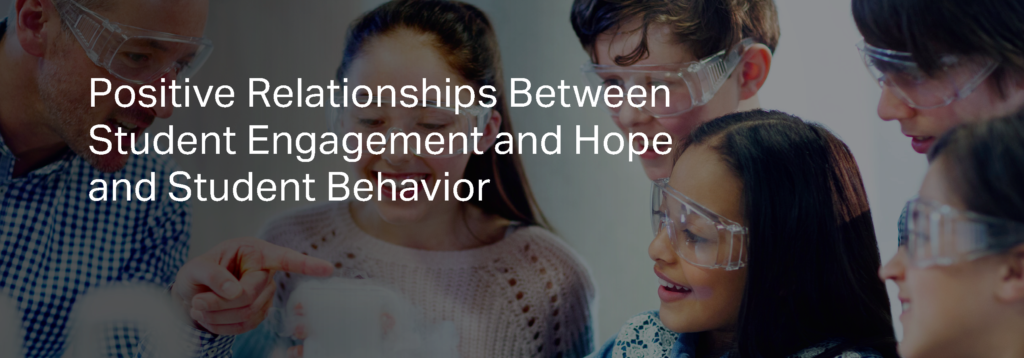 Gallup Study: Positive Relations Between Student Engagement & Hope and Student Behavior this study has proven engagement and hope measurements to be significantly negatively related to student discipline and behavior outcomes at a school level. Consequently, this study has provided a path for districts and schools to proactively build a positive culture and environment at the school and classroom level that supports students emotionally and socially — while positively impacting student behavior outcomes. Read more. . .
Gallup Study: Positive Relations Between Student Engagement & Hope and Student Behavior this study has proven engagement and hope measurements to be significantly negatively related to student discipline and behavior outcomes at a school level. Consequently, this study has provided a path for districts and schools to proactively build a positive culture and environment at the school and classroom level that supports students emotionally and socially — while positively impacting student behavior outcomes. Read more. . .
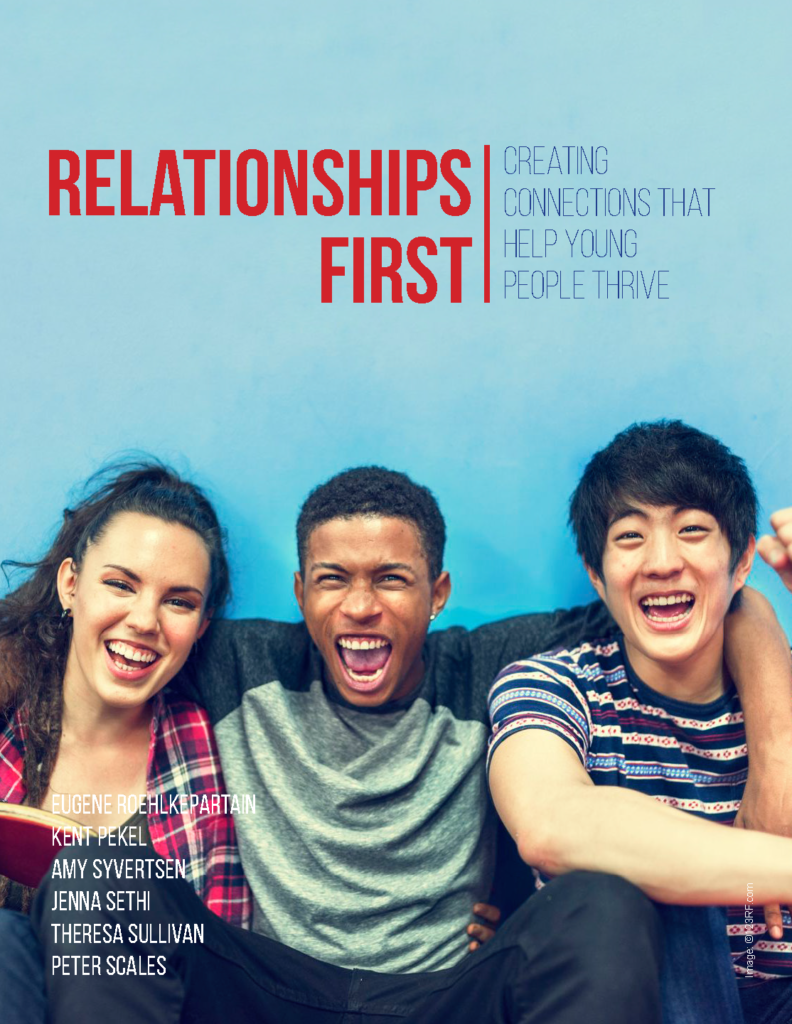 Relationships First: Creating Connections that Help Young People Thrive “It’s all about relationships.” That statement has become a cliché, whether the focus is on parenting, mentoring, teaching, coaching, raising money for a cause, getting a job, or finding a partner. And the cliché has research behind it: We’ve known for decades that high-quality relationships are essential to young people’s growth, learning, and thriving—including for those young people who face serious challenges in their lives and in the world around them.
Relationships First: Creating Connections that Help Young People Thrive “It’s all about relationships.” That statement has become a cliché, whether the focus is on parenting, mentoring, teaching, coaching, raising money for a cause, getting a job, or finding a partner. And the cliché has research behind it: We’ve known for decades that high-quality relationships are essential to young people’s growth, learning, and thriving—including for those young people who face serious challenges in their lives and in the world around them.
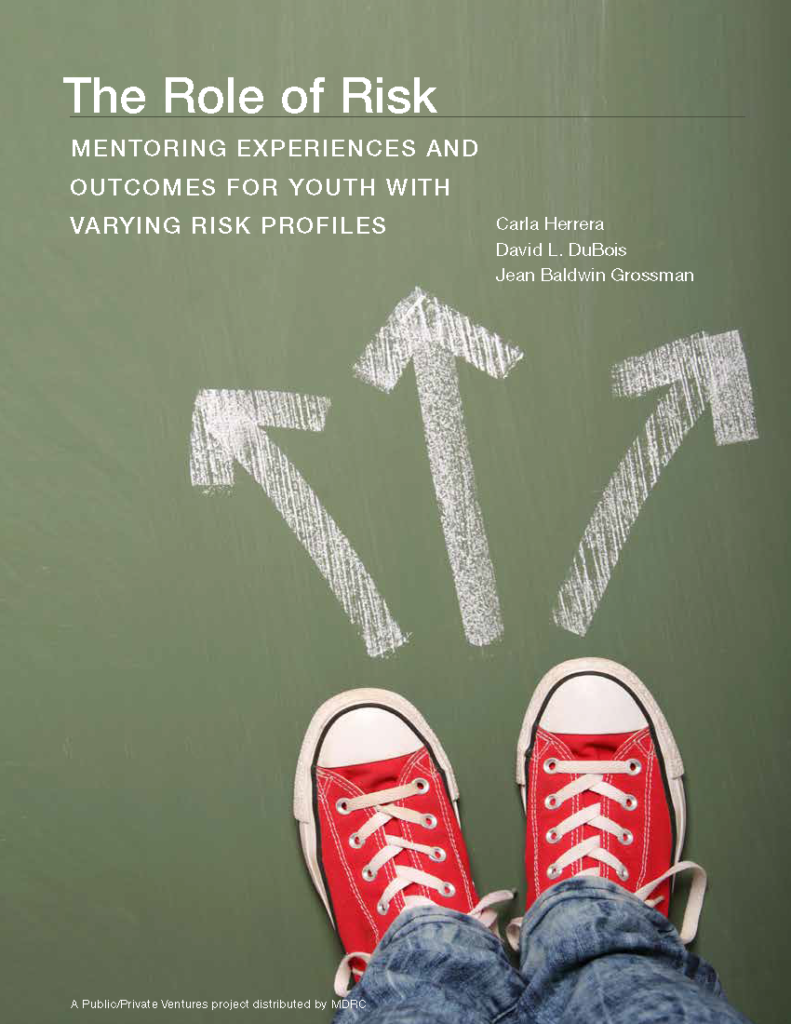 The Role of Risk: Mentoring Experiences and Outcomes for Youth with Varying Risk Profiles presents findings from the first large-scale study to examine how the levels and types of risk youth face may influence their relationships with program-assigned mentors and the benefits they derive from these relationships. Carla Herrera, David L. DuBois, Jean Baldwin Grossman.
The Role of Risk: Mentoring Experiences and Outcomes for Youth with Varying Risk Profiles presents findings from the first large-scale study to examine how the levels and types of risk youth face may influence their relationships with program-assigned mentors and the benefits they derive from these relationships. Carla Herrera, David L. DuBois, Jean Baldwin Grossman.
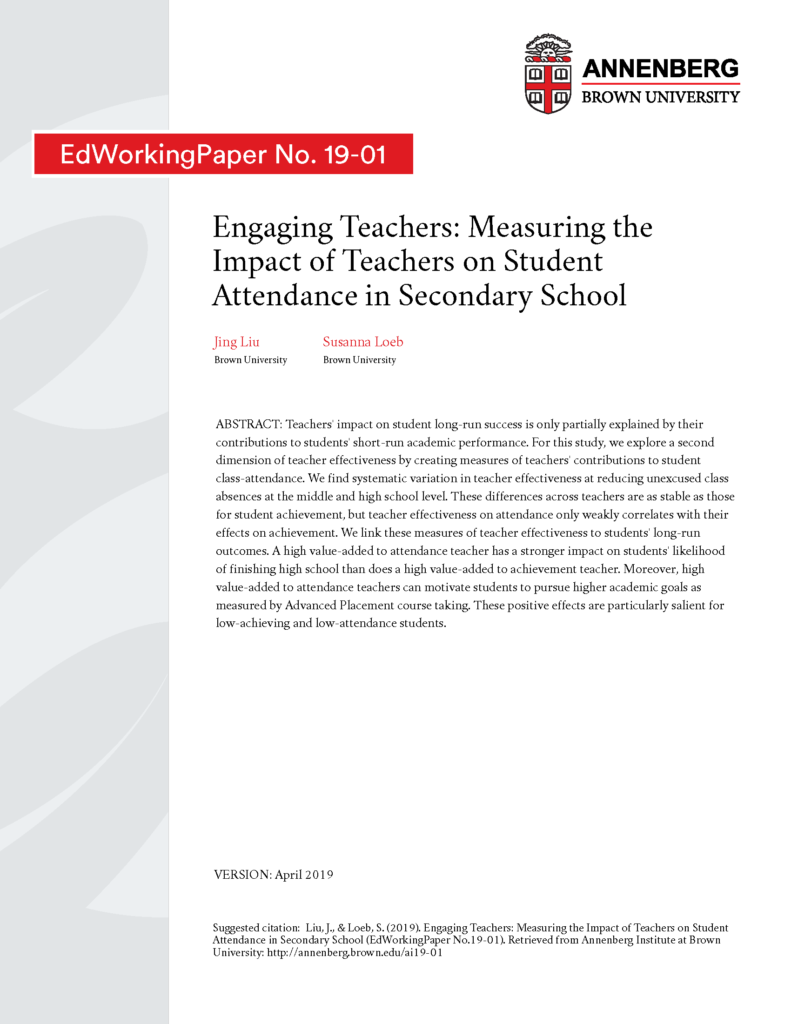 Engaging Teachers: Measuring the Impact of Teachers on Student Attendance in Secondary School Teachers’ impact on student long-run success is only partially explained by their contributions to students’ short-run academic performance. For this study, we explore a second dimension of teacher effectiveness by creating measures of teachers’ contributions to student class-attendance.
Engaging Teachers: Measuring the Impact of Teachers on Student Attendance in Secondary School Teachers’ impact on student long-run success is only partially explained by their contributions to students’ short-run academic performance. For this study, we explore a second dimension of teacher effectiveness by creating measures of teachers’ contributions to student class-attendance.
School-Based Mentoring Programs: Using Volunteers to Improve the Academic Outcomes of Underserved Students the overarching aim of this paper is to enrich the field’s understanding of how volunteer mentors can best support the academic mission of schools. Amanda Bayer, Swarthmore College; Jean Grossman, Princeton University; and David DuBois, University of Illinois at Chicago.
Building Hope, Agency & Pupose
Structures for Belonging: A Synthesis of Research on Belonging-Supportive Learning Environments Student Experience Research Network (SERN) has had the privilege of learning about student belonging from stakeholders across academia and education over the past few years. We’ve been compelled by rigorous scholarship across disciplines and methods that verifies what students and educators know intuitively: belonging is a vital ingredient for learning and well-being. View the resources.
 Going to school is optional: Schools need to engage students to increase their lifetime opportunities is a report featured on the Brookings website by authors Jing Liu, Doctoral student, Economics of Education – Stanford Graduate School of Education and Susanna Loeb, Nonresident Senior Fellow – Economic Studies, Center on Children and Families.
Going to school is optional: Schools need to engage students to increase their lifetime opportunities is a report featured on the Brookings website by authors Jing Liu, Doctoral student, Economics of Education – Stanford Graduate School of Education and Susanna Loeb, Nonresident Senior Fellow – Economic Studies, Center on Children and Families.
Click to Read the Report Online
![]() Reducing socioeconomic disparities in the STEM pipeline through student emotion regulation Increasing access to Science, Technology, Engineering, and Math (STEM) fields can create career opportunities. Yet many students, especially those from lower-income backgrounds, find the high-stakes exams in courses necessary for STEM success to be stressful and anxiety provoking. Critically, emotion regulation interventions cut in half the course failure rate for lower-income students. Formany students, success is based on more than STEM knowledge—their ability to regulate emotions is important too.
Reducing socioeconomic disparities in the STEM pipeline through student emotion regulation Increasing access to Science, Technology, Engineering, and Math (STEM) fields can create career opportunities. Yet many students, especially those from lower-income backgrounds, find the high-stakes exams in courses necessary for STEM success to be stressful and anxiety provoking. Critically, emotion regulation interventions cut in half the course failure rate for lower-income students. Formany students, success is based on more than STEM knowledge—their ability to regulate emotions is important too.
Incorporating Student Voice
Listen to How Teachers Can Help Students Feel Seen on “This Teenage Life” in this Podcast episode, “Feeling Seen,” looks at how teachers can connect with teens not just as students, but as whole humans and unique individuals. How does this help them learn? Listen to the Podcast.
Video: Student Voices – A group of high school students from Baltimore, MD work together in four groups to design a 21st Century high school.
- The Significance of High School Practices on Students’ Four-Year College Enrollment from the Research Alliance for New York City Schools outlines there are two major challenges facing both research and policy related to accountability for postsecondary outcomes. First, we know relatively little about the conditions under which students are successful in getting college and career ready. Second, we do not yet know in the New York City context to what extent school-level differences in college-going rates are the function of compositional differences. Download the Report (PDF)
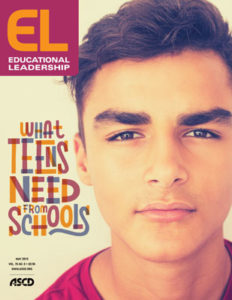 Teen Voices: What We Really Need from Schools To get some insider perspectives for this issue, Educational Leadership editors reached out to several teens across the country, inviting them to tell us about their school experiences and what their biggest challenges are. We asked them: What do you most need from your school, your teachers, your community? Read what they said.
Teen Voices: What We Really Need from Schools To get some insider perspectives for this issue, Educational Leadership editors reached out to several teens across the country, inviting them to tell us about their school experiences and what their biggest challenges are. We asked them: What do you most need from your school, your teachers, your community? Read what they said.
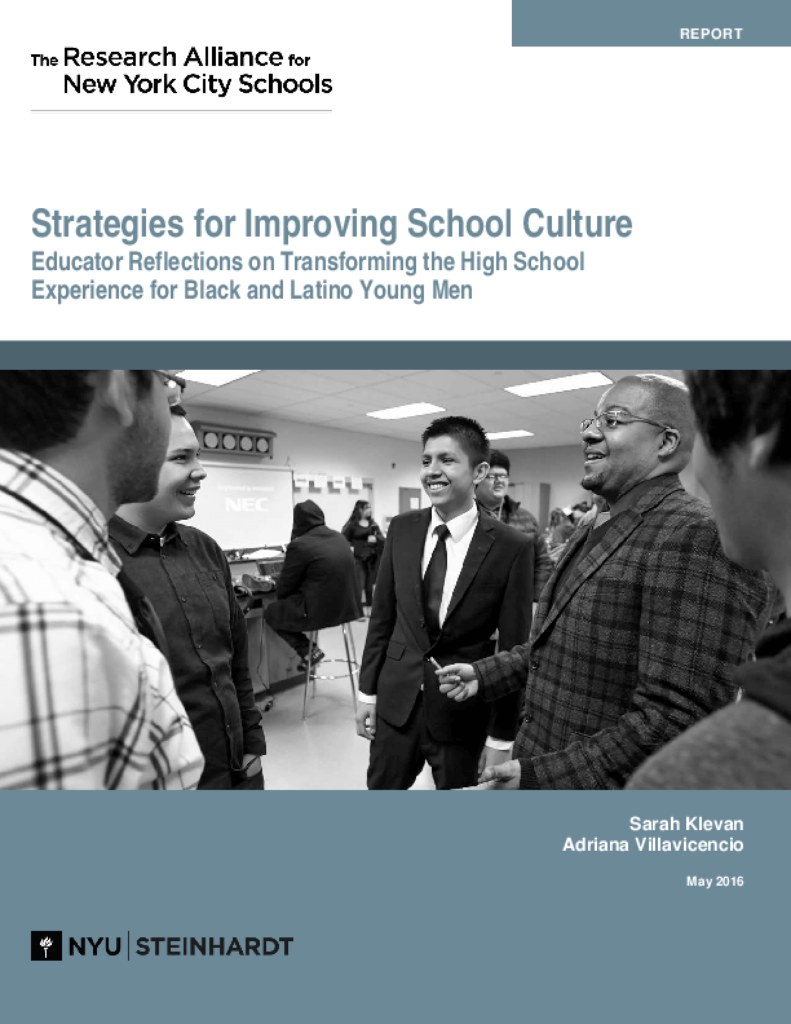 Strategies for Improving School Culture from the Research Alliance for New York City Schools educators reflections on transforming the high school experience for Black and Latino young men. Download the Report (PDF)
Strategies for Improving School Culture from the Research Alliance for New York City Schools educators reflections on transforming the high school experience for Black and Latino young men. Download the Report (PDF)
Building a Safe & Trusting School Climate
- WWC Intervention Report: My Teaching Partner–Secondary by the Institute of Education Sciences is a professional development program that aims to increase student learning and development through improved teacher–student interactions. Download the Report (PDF)
- The Association Between Student Reports of Classmates’ Disruptive Behavior and Student Achievement this study examines the relation between student reports regarding disciplinary infractions to student achievement, with a special focus on classroom disruptions. Download the Report (PDF)
- Student Trust in Teachers and Student Perceptions of Safety this study examined the effects of student trust in teacher and student perceptions of safety on identification with school. Data was collected from one large urban district in an eastern state. Download the Report (PDF)
- Too Scared to Learn? The Academic Consequences of Feeling Unsafe in the Classroom using a unique panel data set of survey responses from New York City middle school students, this article provides insight into the relationship between feelings of safety in the classroom and academic achievement. Download the Report (PDF)
- Authoritative School Climate and High School Student Risk Behavior this study tested the hypothesis that an authoritative school climate characterized by strict but fair discipline and supportive teacher–student relationships is conducive to lower risk behavior for high school students. Download the Report (PDF)
- Loss of Institutional Trust Among Racial and Ethnic Minority Adolescents: A Consequence of Procedural Injustice and a Cause of Life-Span Outcomes Download the PDF
Student Response Systems and Community Support
- Falling Off Track During the Transition to High School: What We Know and What Can Be Done by Ruth Curran Neild examines four theories about why ninth grade poses difficulties for some students. Download the Report (PDF)
- Not Too Late: Improving Academic Outcomes for Disadvantaged Youth from the Institute for Policy Research reports on a randomized controlled trial of a school-based intervention that provides disadvantaged youth with intensive individualized academic instruction. Download the Report (PDF)
- A National and Across-State Profile on Adverse Childhood Experiences Among U.S. Children and Possibilities to Heal and Thrive Issue Brief this issue brief offers hope and a way forward so that all children and their families can attain optimal physical, social, and emotional development and well-being. Download the Report (PDF)
 Preventing Dropout in Secondary Schools This report was prepared for the National Center for Education Evaluation and Regional Assistance, Institute of Education Sciences. Download the Report (PDF)
Preventing Dropout in Secondary Schools This report was prepared for the National Center for Education Evaluation and Regional Assistance, Institute of Education Sciences. Download the Report (PDF)
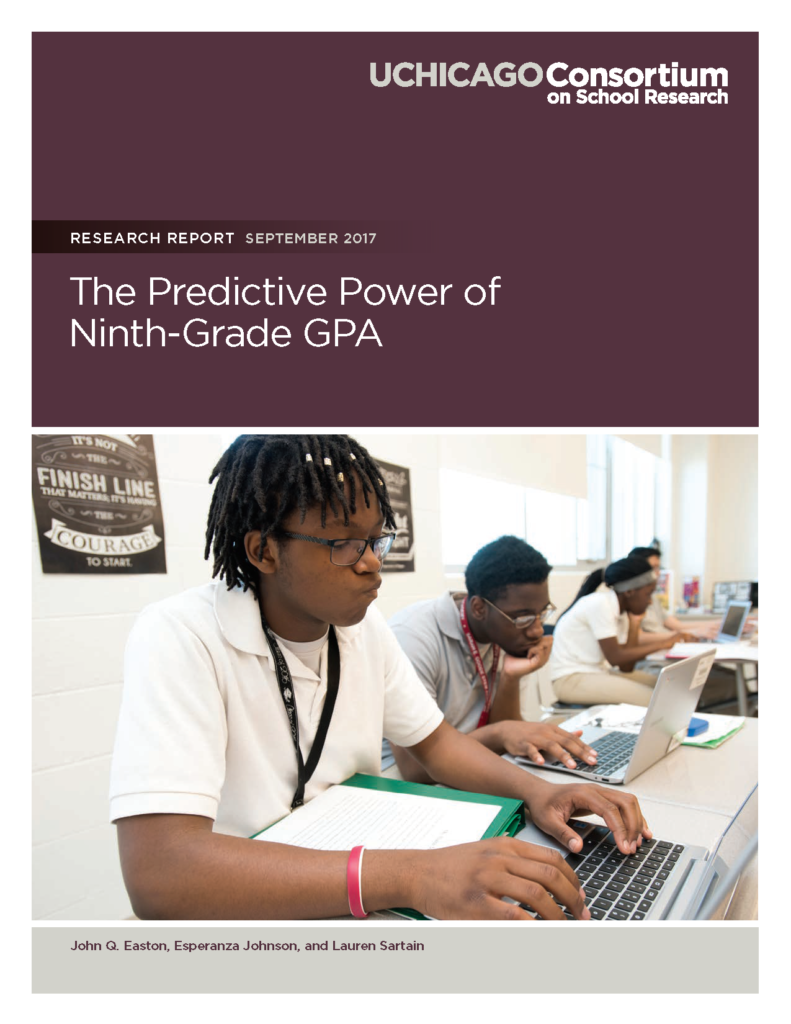 The Predictive Power of Ninth-Grade GPA high schools in Chicago Public Schools (CPS) emphasize the importance of freshman year, specifically the need for students to earn passing grades. There are two important aspects of this focus: its emphasis on freshman year, and its targeting of grades rather than test scores. A large body of research supports this approach. Much of the research has been conducted in Chicago, but has also been widely replicated across the country. Download the Report (PDF)
The Predictive Power of Ninth-Grade GPA high schools in Chicago Public Schools (CPS) emphasize the importance of freshman year, specifically the need for students to earn passing grades. There are two important aspects of this focus: its emphasis on freshman year, and its targeting of grades rather than test scores. A large body of research supports this approach. Much of the research has been conducted in Chicago, but has also been widely replicated across the country. Download the Report (PDF)
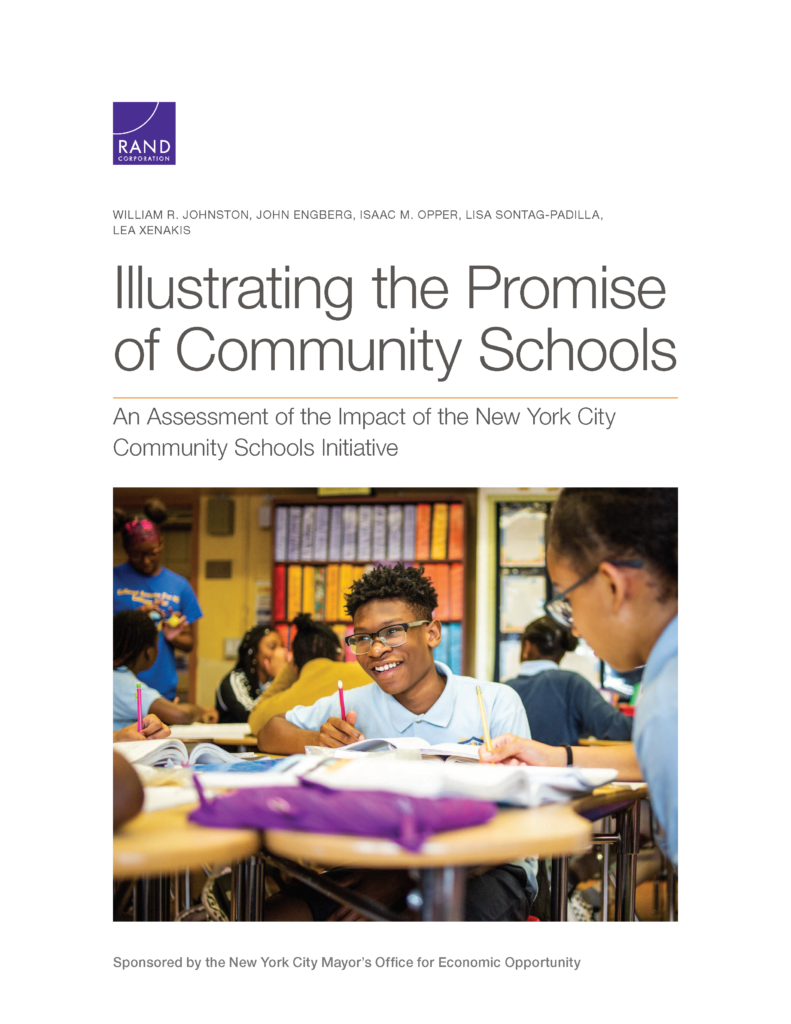 Illustrating the Promise of Community Schools-An Assessment of the Impact of the New York City Community Schools Initiative With the launch of the New York City Community Schools Initiative (NYC-CS) in 2014, the New York City Department of Education (NYCDOE) has increased its focus on the implementation of a holistic strategy of education reform to address the social consequences of poverty as a means to improving student outcomes. NYC-CS is a strategy to organize resources in schools and share leadership among stakeholders so that academics, health and wellness, youth development, and family engagement are integrated into the fabric of each school. Download the Report (PDF)
Illustrating the Promise of Community Schools-An Assessment of the Impact of the New York City Community Schools Initiative With the launch of the New York City Community Schools Initiative (NYC-CS) in 2014, the New York City Department of Education (NYCDOE) has increased its focus on the implementation of a holistic strategy of education reform to address the social consequences of poverty as a means to improving student outcomes. NYC-CS is a strategy to organize resources in schools and share leadership among stakeholders so that academics, health and wellness, youth development, and family engagement are integrated into the fabric of each school. Download the Report (PDF)
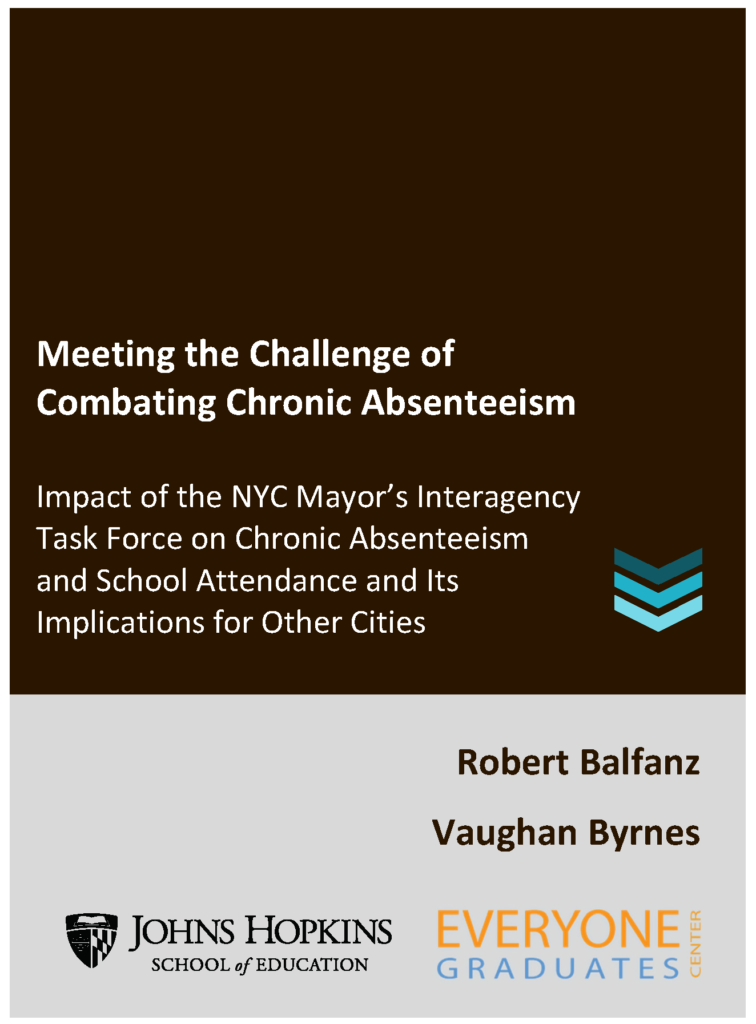 Meeting the Challenge of Combating Chronic Absenteeism from the Everyone Graduates Center at Johns Hopkins University School of Education examines the extent and nature of chronic absenteeism in New York City in schools with above‐average rates of chronic absenteeism which were the focus of the task force’s efforts. It investigates the impact of entering and exiting chronic absenteeism on academic outcomes. Finally, it examines the impact of the task force’s chronic absenteeism prevention and intervention programs on reducing chronic absenteeism and increasing school attendance – and what that means for other cities. Download the Report (PDF)
Meeting the Challenge of Combating Chronic Absenteeism from the Everyone Graduates Center at Johns Hopkins University School of Education examines the extent and nature of chronic absenteeism in New York City in schools with above‐average rates of chronic absenteeism which were the focus of the task force’s efforts. It investigates the impact of entering and exiting chronic absenteeism on academic outcomes. Finally, it examines the impact of the task force’s chronic absenteeism prevention and intervention programs on reducing chronic absenteeism and increasing school attendance – and what that means for other cities. Download the Report (PDF)
 Diplomas Now: Findings from the First Decade and What’s Next examines how an evidence-based, collaborative, whole-school improvement model, leveraging its partners, members and early warning systems can accelerate student and school success in the highest-need schools. Download the Report (PDF)
Diplomas Now: Findings from the First Decade and What’s Next examines how an evidence-based, collaborative, whole-school improvement model, leveraging its partners, members and early warning systems can accelerate student and school success in the highest-need schools. Download the Report (PDF)
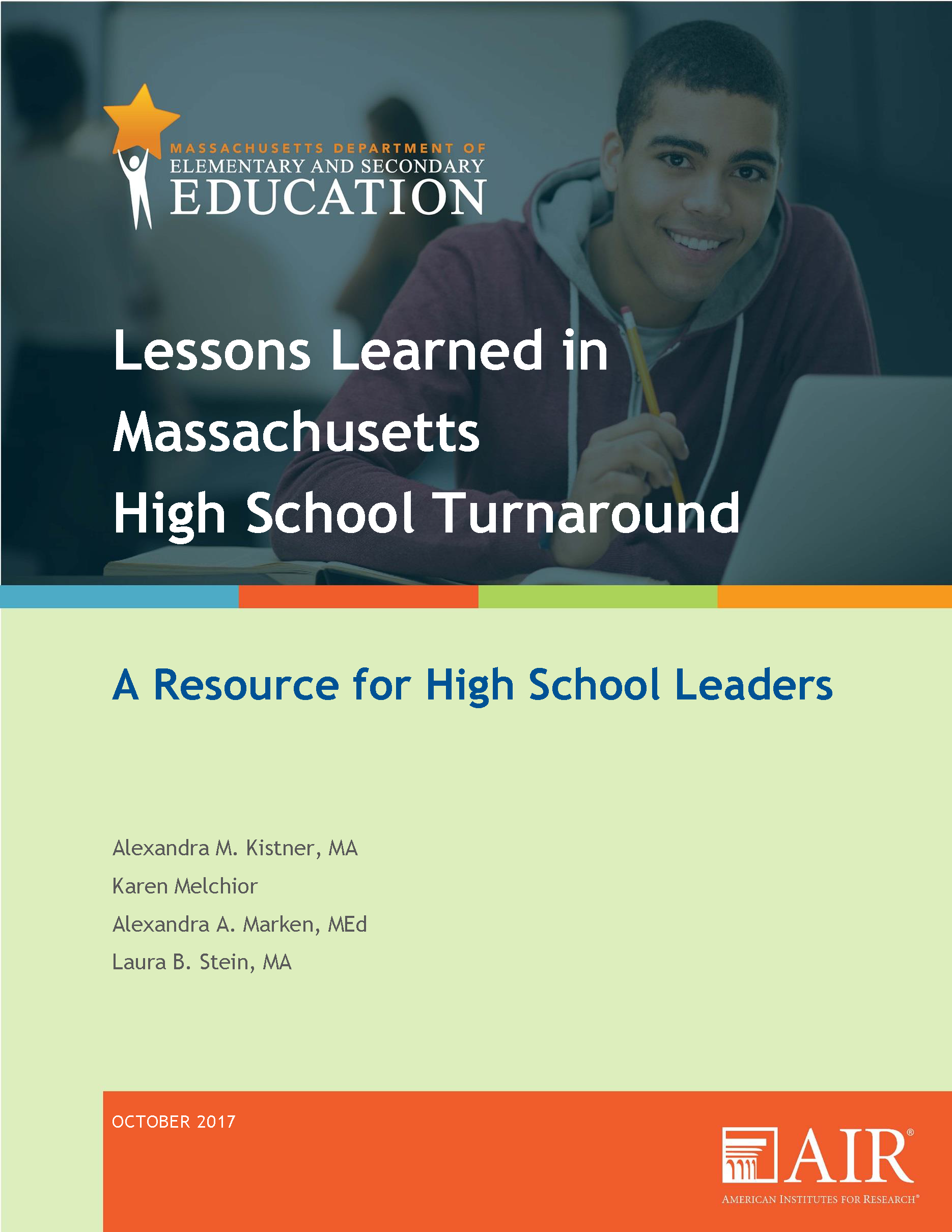 Lessons Learned in Massachusetts High School Turnaround a resource for high school leaders produced by Massachusetts Department of Elementary and Secondary Education and the American Institutes for Research. Download the Report (PDF)
Lessons Learned in Massachusetts High School Turnaround a resource for high school leaders produced by Massachusetts Department of Elementary and Secondary Education and the American Institutes for Research. Download the Report (PDF)
Implementing Evidence-Based Strategies
This section examines the “how” and “why” of the evidence and research base and supports core principles to consider when redesigning high school such as, staffing and how to most effectively deploy the adults in your school, teaming and leadership structures to facilitate strong relationships between adults and students.
Integrating Social Emotional Learning (SEL)
Developing of Skills, Habits, and Mindsets In a district where two thirds of students once failed to graduate, the new school enabled 90% of students to graduate and 90% to go on to college by creating the conditions for cognitive, social, and emotional learning. Read and Download the Report.
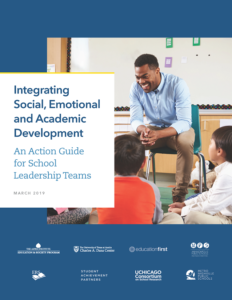 Integrating Social, Emotional, and Academic Development is an action guide provides school leadership teams with a resource for integrating the social, emotional and academic needs of young people into the daily student experience, from the time a bus driver greets a student until the end of the day. It supports the school leader and her/his team in mapping out an approach for integrating the social, emotional, and academic needs of students into the way adults and students experience school each moment of each school day.
Integrating Social, Emotional, and Academic Development is an action guide provides school leadership teams with a resource for integrating the social, emotional and academic needs of young people into the daily student experience, from the time a bus driver greets a student until the end of the day. It supports the school leader and her/his team in mapping out an approach for integrating the social, emotional, and academic needs of students into the way adults and students experience school each moment of each school day.
CASEL and its collaborators developed The District Resource Center website to share learnings about systemic SEL implementation, including learnings, resources, tools, and artifacts curated from CDI districts. The website enables district leaders and educators around the country to access information about how these districts approached the work and overcame challenges, highlighting the successes they’ve achieved. Visit The District Resource Center
Don’t know where to start? Use DRC’s Priority Setting Questionnaire to reflect on your current SEL approach.
Using CASEL’s District Framework, you will be guided through an assessment of your current implementation status to help identify which areas are of highest priority for future focus. Begin the Priority Setting Questionnaire.
Building Strong, Positive Student Relationships
“People First, Students Second”: Considerations for Building Trusting Relationships Between Educational Professionals and Adolescents in Schools by Tarsha I. Herelle, Martha Abele MacIver, and Mariko Yoshisato Cavey
Students’ relationships with adults in educational environments require careful consideration from researchers and practitioners as we seek to improve educational outcomes, particularly for those who have been historically underserved. This qualitative case study extends research on the development of student-teacher trust to a broader group of adults within the school by focusing on the work of City Year (CY) AmeriCorps members (ACMs), serving as in-school student success coaches and their in-school CY leaders, Impact Managers. We use data from adult student success coaches and leaders in two urban districts to examine how young adults temporarily serving in student support roles developed trusting relationships with youth and how they perceived their contribution to students’ academic and social-emotional growth. Findings show despite the temporal nature of their role, CY staff across sites and grade levels develop trust with students by using human-centered approaches, being vulnerable and honest with students, and setting clear boundaries. The participants’ voices in this study provide interpersonal strategies for teachers, teaching assistants, counselors, mentors, and staff to consider when building holistic and authentic relationships with students. Click here to read the full report
Structures for Belonging: A Research Synthesis What do we know about creating and sustaining environments that support belonging for each student? To answer this question, Student Experience Research Network developed Structures for Belonging, a research synthesis that illuminates structures – or practices, policies, and norms – related to belonging in four overlapping categories: access to learning environments; relationships with educators, peers, and families; instructional resources and pedagogy; and system-level policies and practices. The synthesis discusses both K-12 and postsecondary educational contexts, and includes research from diverse academic disciplines including social psychology, cultural psychology, sociology, adolescent development, neuroscience, economics, and education. https://studentexperiencenetwork.org/structures-for-belonging-a-synthesis-of-research-on-belonging-supportive-learning-environments/
Video: Report Card Conferences – Report Card Conferences are held between students and non-school affiliated adults. Caring adults, which are typically caring adults from the community, review a student’s report card along with their Attendance, Behavior, and Course Performance. RCCs give students the opportunity to speak with caring adults who reinforce the value of success in school and encourage them to get help when experiencing difficulty.
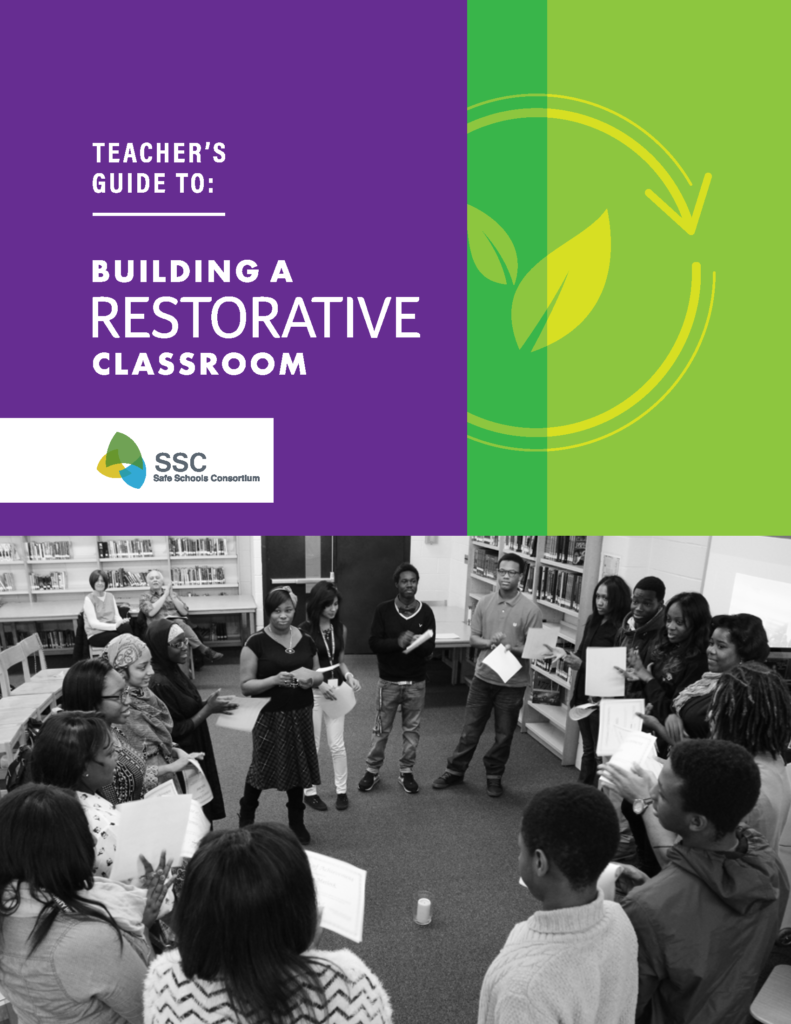 Teacher’s Guide to Building a Restorative Classroom in this guide, you will both deepen your understanding of restorative justice (RJ) principles and philosophy, and learn strategies to help live these principles with your students. Download the Guide (PDF)
Teacher’s Guide to Building a Restorative Classroom in this guide, you will both deepen your understanding of restorative justice (RJ) principles and philosophy, and learn strategies to help live these principles with your students. Download the Guide (PDF)
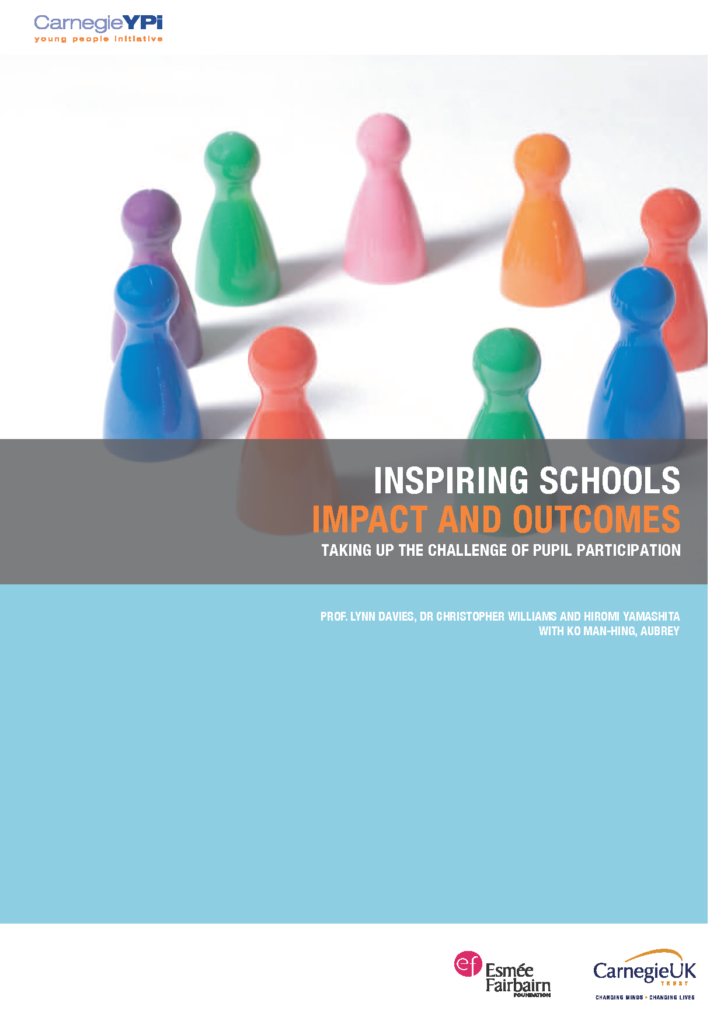 Inspiring School, Impact and Outcomes is a study to search for evidence of the impact of student participation in schools and colleges. It used a definition of participation as involvement in a collective decision-making process with a recognisable social and/or educational outcome.
Inspiring School, Impact and Outcomes is a study to search for evidence of the impact of student participation in schools and colleges. It used a definition of participation as involvement in a collective decision-making process with a recognisable social and/or educational outcome.
It therefore limited the search to:
- a focus on participation in decision-making (that is, not just any ‘taking part’ in school or lessons);
- a focus on impact and outcomes (that is, not just being descriptive of participatory activities, or evaluating materials and toolkits).
Seventy five studies, mainly from UK, but also internationally, were scrutinised. An annotated bibliography to support this study was produced and is published separately online at: www.carnegie-youth.org.uk. Download the Study (PDF)
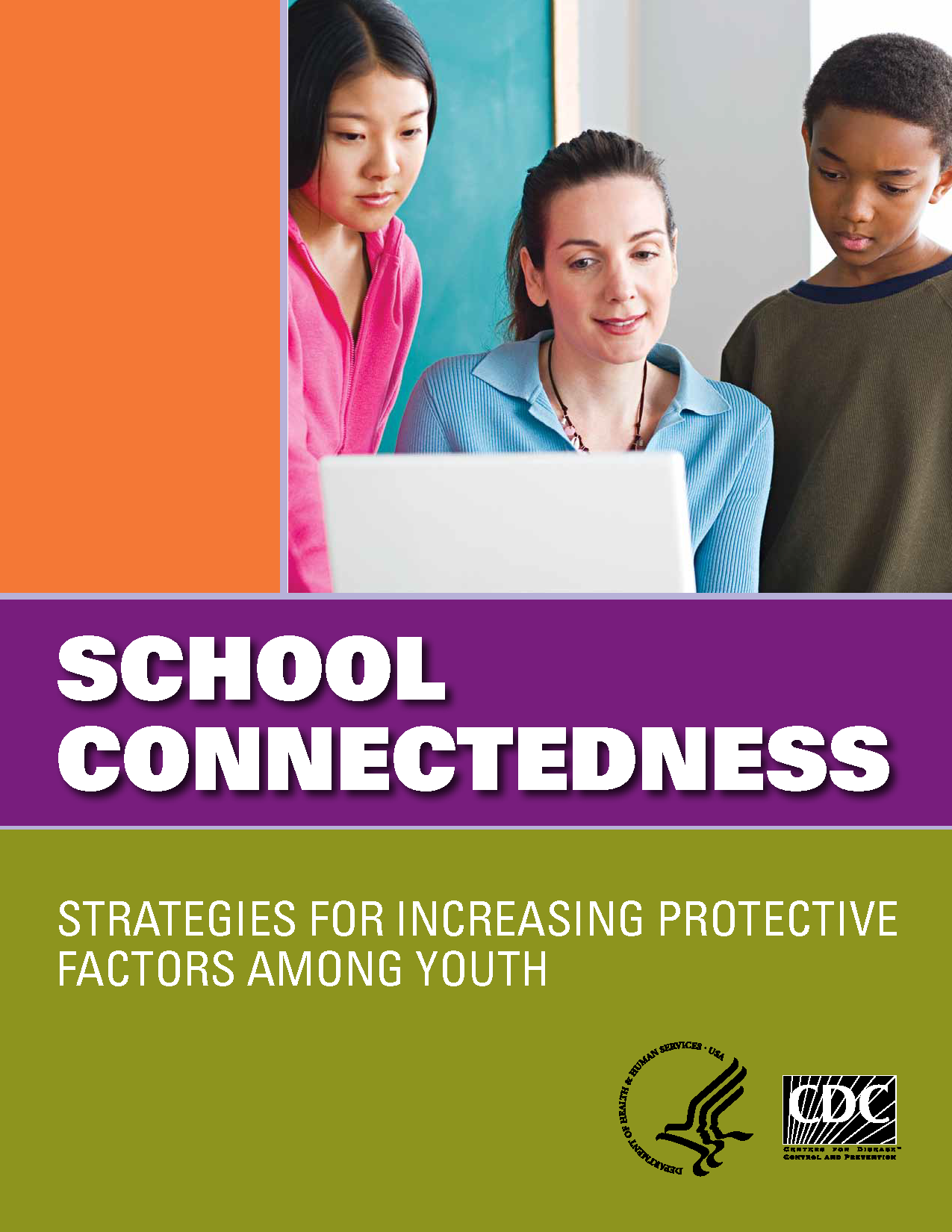 Efforts to improve child and adolescent health typically have featured interventions designed to address specific health risk behaviors, such as tobacco use, alcohol and drug use, violence, gang involvement, and early sexual initiation. However, results from a growing number of studies suggest that greater health impact might be achieved by also enhancing protective factors that help children and adolescents avoid multiple behaviors that place them at risk for adverse health and educational outcomes. Enhancing protective factors also might buffer children and adolescents from the potentially harmful effects of negative situations and events, such exposure to violence.
Efforts to improve child and adolescent health typically have featured interventions designed to address specific health risk behaviors, such as tobacco use, alcohol and drug use, violence, gang involvement, and early sexual initiation. However, results from a growing number of studies suggest that greater health impact might be achieved by also enhancing protective factors that help children and adolescents avoid multiple behaviors that place them at risk for adverse health and educational outcomes. Enhancing protective factors also might buffer children and adolescents from the potentially harmful effects of negative situations and events, such exposure to violence.
- Helping students feel seen and understood. Along.com is a digital reflection tool that makes it easier for teachers to check in one-on-one with each student. The website offers free tools to help teachers build and sustain relationships with students-its both a series of prompts and supporting activities based on the Search Institutes Development Relationship framework and a digital distribution, communication and archiving system-that lets teachers connect to students outside of class via video, text, or email.Visit Along.com
- Overcoming the Poverty Challenge to Enable College and Career Readiness for All examines the important and under-conceptualized thread in the weave of efforts needed to ensure that all students graduate from high school prepared for college and/or career training: enhanced student supports. Download the Report (PDF)
Student Growth Mindsets
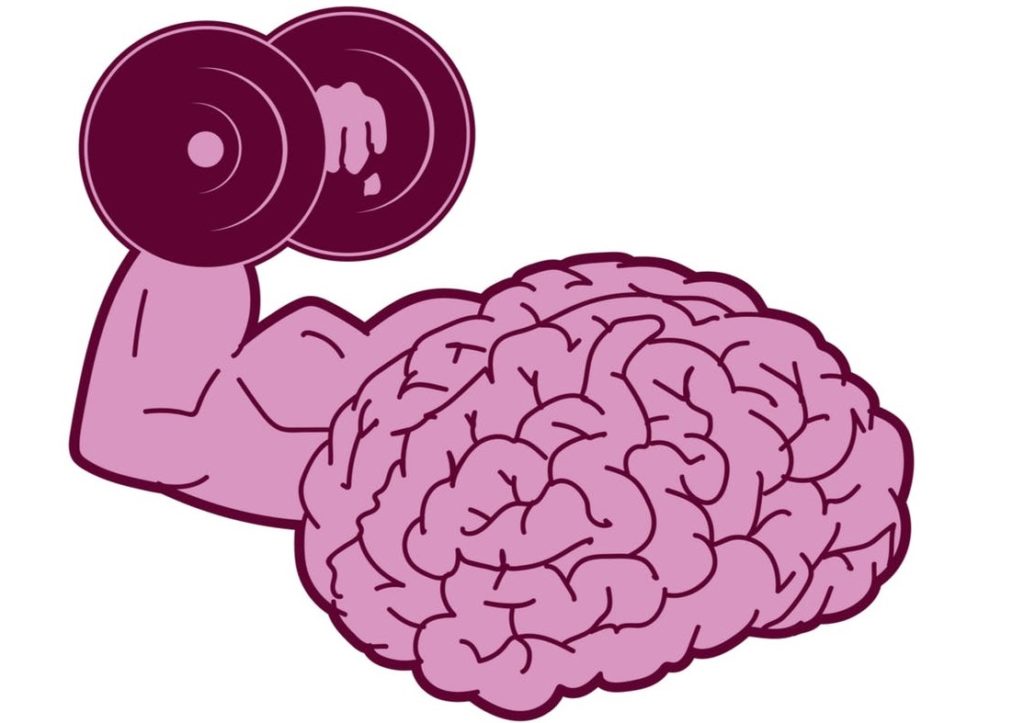 New Study Shows Where ‘Growth Mindset’ Training Works (And Where It Doesn’t) A large nationwide study has found that teaching ninth graders to maintain a “growth mindset” toward learning—stressing that their minds are like muscles that can get stronger with use—can result in higher test scores. Download the Report (Adobe PDF)
New Study Shows Where ‘Growth Mindset’ Training Works (And Where It Doesn’t) A large nationwide study has found that teaching ninth graders to maintain a “growth mindset” toward learning—stressing that their minds are like muscles that can get stronger with use—can result in higher test scores. Download the Report (Adobe PDF)
The study, published today in the journal Nature, is the largest and most rigorous test of whether mindset trainings can improve student performance. The concept is already well-known in education circles, and it has gained national attention thanks to books and TED talks by Carol Dweck, an education professor at Stanford University. Dweck is a co-author of the study released today. Read the article.
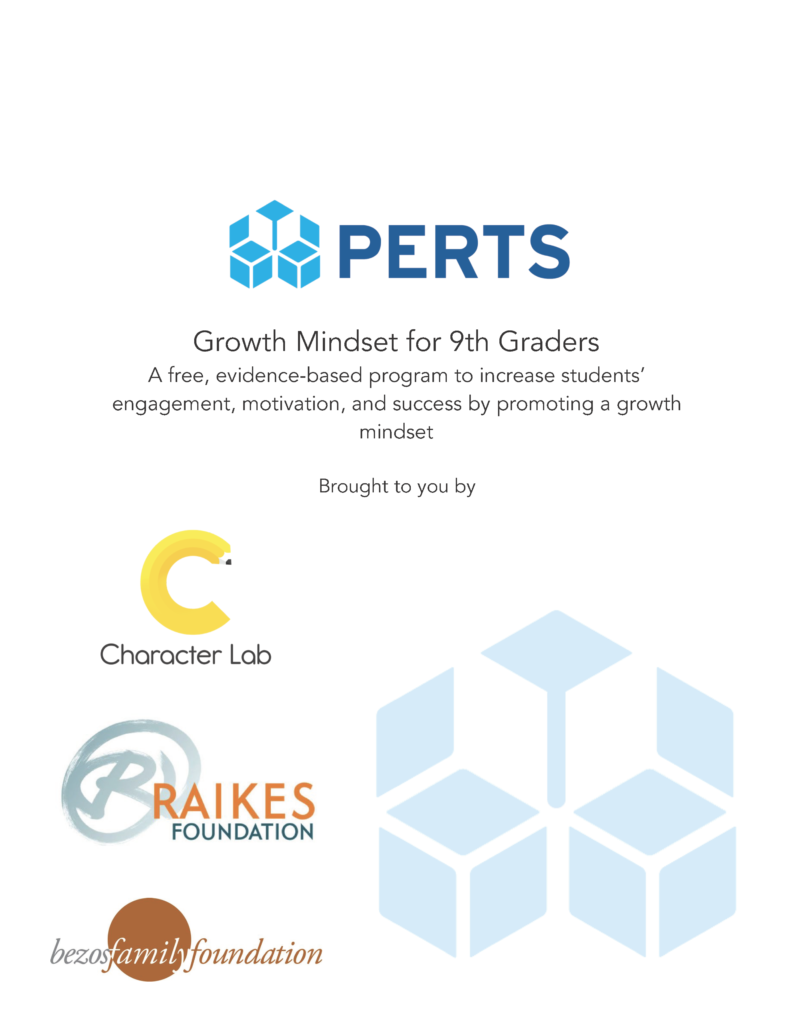 Growth Mindset for 9th Graders
Growth Mindset for 9th Graders
Many students hold debilitating beliefs about their intelligence. They believe things like, “I’m not smart enough” or “This subject just isn’t for me.” These beliefs can be especially damaging during the academically and socially challenging transition to high school.
Research shows, however, that schools can boost performance—particularly for students with a history of academic struggle—by helping students develop a growth mindset: the belief that they can develop their academic abilities through effective study strategies. Growth Mindset for 9th Graders is designed to help students understand that academic aptitude can be improved. Learn more about this free program.
Download the Program Information Packet to learn more about the research and how to run Growth Mindset for 9th Graders at your school.
The Missing Metrics: Emerging practices for measuring students’ relationships and networks A large nationwide study has found that teaching ninth graders to maintain a “growth mindset” toward learning—stressing that their minds are like muscles that can get stronger with use—can result in higher test scores. Download the Report
College & Career Readiness
Work-Based Learning Deeper Learning and Career Preparation Through Real-World, Professional Eexperiences Work-based learning (WBL) connects classroom instruction with real-world, professional experiences. In this approach, learning takes place within the context of a workplace, allowing students to apply what they learn in the classroom to a career-based experience. Read more.
To Meet New State Graduation Rules, a Philadelphia School Holds Students and Staff Accountable Click here to read the article
Engaging Student Voices
Student Voice Toolkit – The Search Institute designed a few tools and resources that might support schools and educators in developing and refining student voice practices in K-12 schools, so that they can involve students more effectively in classroom and school decision-making.
Teen Voices: What We Really Need from Schools – To get some insider perspectives for this issue, Educational Leadership editors reached out to several teens across the country, inviting them to share their school experiences and what their biggest challenges are.
We asked them: What do you most need from your school, your teachers, your community? Here’s what they said.
Video: Students’ Voices/Students’ Visions – a ten-minute video featuring urban high school students from Baltimore, MD dicussing four topics:
- School Design
- Learning
- School & Community
- Business & Wealth
Podcast: Student Agency & Engagement
Michele Cahill hosts a discussion with experts about how to co-create learning experiences with young people. Featuring: Travis Bristol, Research and Policy Fellow at the Stanford Center for Opportunity Policy in Education; Zak Malamed, Founder and Executive Director of Student Voice; Eliza Jane Schaeffer, Senior at Henry Clay High School. Click to listen to the Podcast.
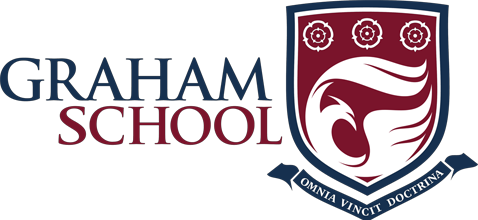 Student Voice as a School Improvement Tool is a case study examining the exploration of the steps Graham School Science and Arts College in Scarborough England have taken to harness Student Voice and used it to inform whole school improvement through the creation of a Student Parliament.
Student Voice as a School Improvement Tool is a case study examining the exploration of the steps Graham School Science and Arts College in Scarborough England have taken to harness Student Voice and used it to inform whole school improvement through the creation of a Student Parliament.
Graham School is a larger than average secondary school in the coastal town of Scarborough. It is split over two sites; a Lower School for Years 7 & 8 and an Upper School for Years 9, 10 & 11. There are currently 1364 students on role and 43% of those are Pupil Premium. Click here for more opinions and views from students.
Learning Communities, Student-Centered Learning
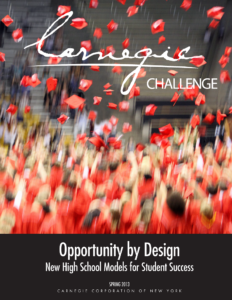 Opportunity by Design is a report produced by the Carnegie Corporation of New York examines while it is important to graduate from high school, high school is not an end in itself, but rather preparation for college as well as life-long learning. It is one part of the path that leads students towards their ultimate potential in any of endeavor as well as in personal satisfaction in their lives. To reach these goals, students deserve the best possible education that we can provide.
Opportunity by Design is a report produced by the Carnegie Corporation of New York examines while it is important to graduate from high school, high school is not an end in itself, but rather preparation for college as well as life-long learning. It is one part of the path that leads students towards their ultimate potential in any of endeavor as well as in personal satisfaction in their lives. To reach these goals, students deserve the best possible education that we can provide.
Podcast: Staffing for Student-Centered Learning
Betsy Arons, Geneviève DeBose, Hillary Salmons, and Michele Cahill answer questions and discuss ways to find and retain the best talent for your school. Featuring: Betsy Arons CEO of Urban Schools Human Capital Academy Geneviève DeBose National Board Certified Teacher and Commissioner of National Commission on Teaching and America’s Future Hillary Salmons Executive Director of Providence After School Alliance. Click to listen to the Podcast.
Learning from Stakeholder Voice: School Discipline examines the question, “What do students, families, and staff think about discipline and fairness at their school?” Read more.
- Educational Experiences that Matter to Seniors Graduation from an Urban Early College High School preparing underrepresented students in urban settings for college and career is the focus of this study prepared by SAGE journals. Download the Study (PDF)
- Classroom Q&A a teacher’s blog on Education Week’s website. In this post, Mr. Ferlazzo responds to the question: What are ‘Small Learning Communities’ (dividing large campuses into special interest small schools) and how do they work? Read the Post
Integrating Student Success into Redesign
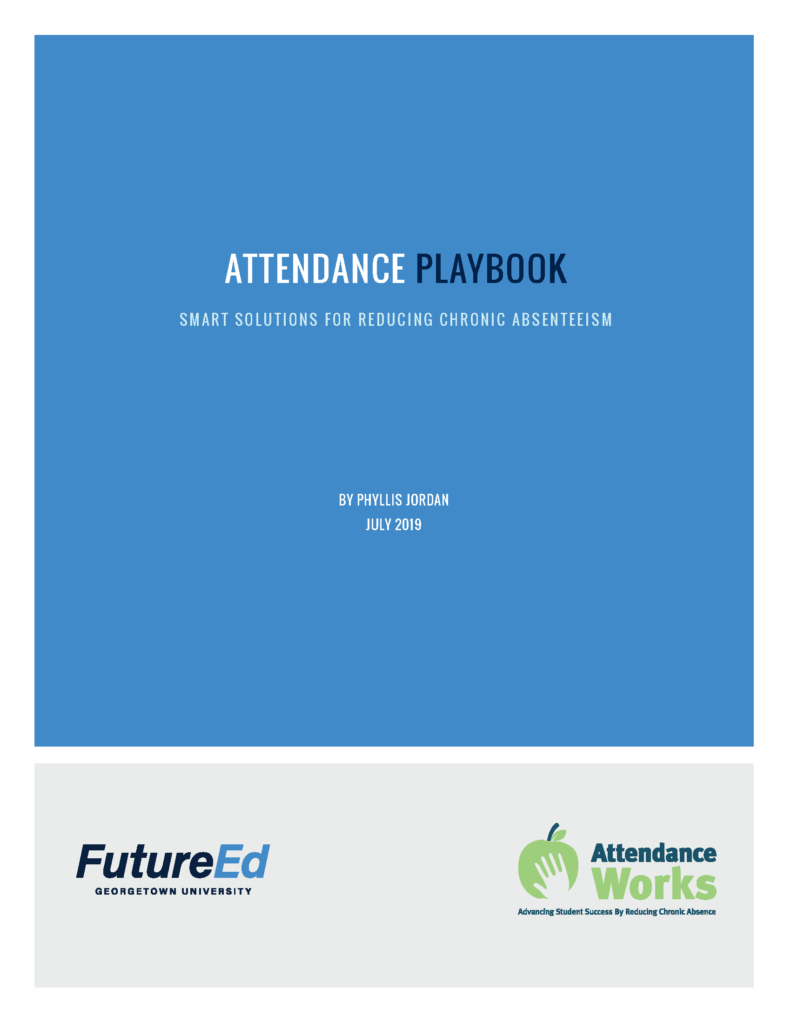 Attendance Playbook Smart Solutions for Reducing Chronic Absenteeism addresses absenteeism at the ground level, providing local policymakers and educators with nearly two dozen practical strategies for improving attendance that have strong track records and are in many instances easy to introduce and simple to scale. It explains each intervention, identify the problem it solves, summarize supporting research, and highlight schools or school districts that have used the strategy successfully. The list isn’t exhaustive, but it represents a substantial sample of the leading work and latest thinking on improving attendance. Download the Playbook (PDF)
Attendance Playbook Smart Solutions for Reducing Chronic Absenteeism addresses absenteeism at the ground level, providing local policymakers and educators with nearly two dozen practical strategies for improving attendance that have strong track records and are in many instances easy to introduce and simple to scale. It explains each intervention, identify the problem it solves, summarize supporting research, and highlight schools or school districts that have used the strategy successfully. The list isn’t exhaustive, but it represents a substantial sample of the leading work and latest thinking on improving attendance. Download the Playbook (PDF)
Pathways to Adult Success The vision of Pathways to Adult Success is for schools, their systems and communities to enable all youth, regardless of their needs, circumstances, place of residence, and prior experiences, to obtain the competencies needed to persist and complete secondary schooling and a post-secondary pathway that leads to a family-supporting wage and adult success. Visit their website.
Overcoming the Poverty Challenge to Enable College and Career Readiness for All examines the important and under-conceptualized thread in the weave of efforts needed to ensure that all students graduate from high school prepared for college and/or career training: enhanced student supports. Download the Report (PDF)
Indicators, Early Warning Systems, and Student Supports
Video: Introduction to Early Warning Systems and Indicators Dr. Robert Balfanz provides and indepth introduction to Early Warning Systems and On-Track Indicators. The video also explores how using these evidence-based systems help keep all students on track for high school graduation and postsecondary success.
Video: Redesigning Student Support Systems – a six-minute video which higlights how high schools can redesign their student support systems using the A-B-Cs of Attendance, Behavior and Course Performance.
Integrated Student Support Systems Social Justice Humanitas Academy is a highly successful community school serving a low-income community in Los Angeles County. There, the needs of the whole child are addressed by integrated support systems that begin with personalized approaches to teaching, advising, and counseling, augmented by a range of fully integrated services, community partnerships, and expanded and enriched learning opportunities. Read or Downlad the Report.
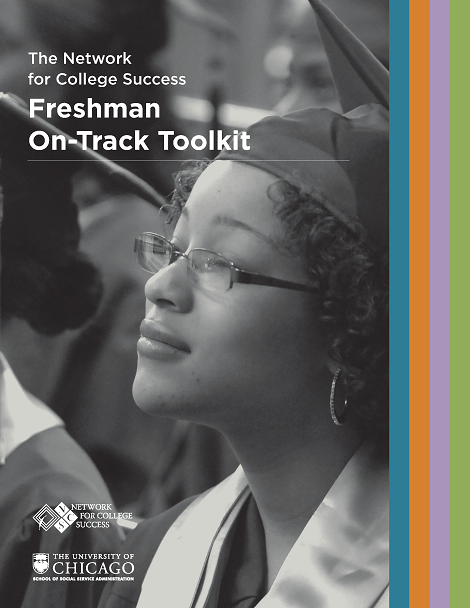 Freshman On-Track Toolkit prepared by the Network for College Success at the University of Chicago, the NCS Freshman On-Track Toolkit is a collection of protocols, reports, resources, and artifacts used by our experienced Coaches in their daily work to help schools better support students through the critical first year of high school.
Freshman On-Track Toolkit prepared by the Network for College Success at the University of Chicago, the NCS Freshman On-Track Toolkit is a collection of protocols, reports, resources, and artifacts used by our experienced Coaches in their daily work to help schools better support students through the critical first year of high school.
 The University of Chicago School of Social Service Administration’s Network for College Success maintains a free, searchable database of tools designed to aid educators in their quest to redesign their schools & keep students on track for graduation and beyond. Read more. . .
The University of Chicago School of Social Service Administration’s Network for College Success maintains a free, searchable database of tools designed to aid educators in their quest to redesign their schools & keep students on track for graduation and beyond. Read more. . .
Overcoming the Poverty Challenge to Enable College and Career Readiness for All examines the important and under-conceptualized thread in the weave of efforts needed to ensure that all students graduate from high school prepared for college and/or career training: enhanced student supports. Download the Report (PDF)
This eight-part, in-depth series examines the benefits and steps to implement an effective Early Warning Indicator program.
The free videos and materials go far beyond how to collect and interpret EWI data. It also examines building a data culture, linking indicators to a tiered inteventions system, planning EWS for schools and districts, how to get an EWS started including, how to introduce school staff and faculty to the system, intervention review and data gap analysis and much more.
Visit the EWI video series home page.
The video series was developed by the Everyone Graduates Center at Johns Hopkins University School of Education in partnership with the New Mexico Public Education Department, and the High Plains Regional Education Cooperative.
Beyond the Indicators: An Integrated School-Level Approach to Dropout Prevention from the Mid-Atlantic Equity Center summarizes the research on why students drop out of school, explains the research implications for how to create an integrated dropout prevention strategy, and highlights an innovative pilot project that yielded results in a matter of months—a how-to example that works. Download the Report (PDF)
Chronic Abesenteeism
Reasons for Chronic Absenteeism Among Secondary Students This report presents information on the results of the Reasons for Chronic Absenteeism (RCA) Survey for secondary students. The data were collected directly from 5,790 chronically absent 6th-12th grade students in 8 states (CA, FL, IA, KY, ME, MI, MN, RI), 21 school districts, and 91 schools. Download the Report (PDF)
Download the Questionnaire (PDF)
Keeping Students at the Center During COVID 19
- Re-engaging Disconnected Students Online and at School: Focus on Intrinsic Motivation from The Center for MH in Schools & Student/Learning Supports at UCLA. Download the PDF
- Guiding Schools’ COVID-19 Recovery Decisions Using Data and Evidence As the pandemic continues, the task of supporting students becomes ever more difficult. The EdResearch for Recovery Project has newly released briefs that are part of a series aimed at providing K-12 education decision makers and advocates with an evidence base to ground discussions about how to best serve students during and following the novel Coronavirus pandemic. Based on a developing list of questions from policymakers and practitioners, the EdResearch for Recovery Project taps top researchers from across the country to develop evidence briefs to inform recovery strategies.
Evidence-Based Practices for Assessing Students’ Social and Emotional Well-Being – Heather Hough (Policy Analysis for California Education at Stanford University), Joe Witte (Policy Analysis for California Education at Stanford University), Caroline Wang (Education Analytics) and Dave Calhoun (CORE Districts)
Leveraging Community Partnerships for Integrated Student Support– Velma McBride Murry (Vanderbilt University), Reuben Jacobsen (American University), Betheny Gross (Center for Reinventing Public Education, University of Washington)
Supports for Students Who Are English Learners (ELs) – Madeline Mavrogordato (Michigan State University), Rebecca Callahan (University of Texas at Austin), David DeMatthews (University of Texas at Austin), Elena Izquierdo (University of Texas at El Paso)
Accelerating Student Learning with High-Dosage Tutoring – Beth Schueler (University of Virginia), Matt Kraft (Annenberg Institute at Brown University), Susanna Loeb (Annenberg Institute at Brown University), Carly Robinson (Annenberg Institute at Brown University)
- Re-engaging Disconnected Students Online and at School: Focus on Intrinsic Motivation from The Center for MH in Schools & Student/Learning Supports at UCLA. As the school year begins, particular attention must be given to practices that engage and re-engage students. Such practices must be designed to sustain students’ involvement in instruction. This is essential to minimizing learning, behavior, emotional problems. It is critical to closing the opportunity and achievement gaps. Download the PDF
- The State of Young People during COVID-19 from America’s Promise Alliance with findings from a nationally representative survey of high school youth. Download the PDF
- Measuring and Improving Student-Centered Learning Toolkit The Measuring and Improving Student-Centered Learning (MISCL) this toolkit is designed to help school practitioners or other stakeholders measure, understand and reflect upon the extent of student-centered learning (SCL) in high schools at: https://studentsatthecenterhub.org/resource/measuring-scl-toolkit/
- Maintaining Ties When School Closes is Critical to Preventing Droupouts is an article from Education Week on ways to keep students connected through the closures of schools at https://blogs.edweek.org/edweek/inside-school-research/2020/03/school_closures_a_critical_time_for_dropout_prevention_efforts.html
- Three Strategies for Better Online Discussions provides strategies for maintaining positive online discussion forums with students and how they differ from classroom discussions from ASCD Inservice at https://inservice.ascd.org/three-strategies-for-better-online-discussions/
- Strategies to Reach All Students The Learning Accelerator shares effective strategies educators have been using to reach as many students as possible: record yourself doing routines you want students to do, use a variety of video and audio platforms, offer multiple session times at https://learningaccelerator.org/blog/week-1-todays-one-thing-for-teachers-building-connections?utm_source=XQ%3A+Give+Me+Five+Newsletter&utm_campaign=6a7d7b9aa9-giveme5_issue_10_COPY_01&utm_medium=email&utm_term=0_fff7d23e53-6a7d7b9aa9-66456997
- Creative Ways to Stay Connected when schools had to close their doors to prevent the spread of coronavirus, educators like you barely had a chance to say goodbye to your students. Why it matters: There’s no real substitute for seeing your students daily, nor should there be. It’s crucial to student learning (and yours) to find ways to stay connected with them. We Are Teachers shares ways to do that: send a letter to your students via snail mail, call students individually to see how they’re doing, remember that you matter and that your best is all you can give. see the fun ways teachers are building classroom community at https://www.weareteachers.com/stay-connected-students/?utm_source=XQ%3A+Give+Me+Five+Newsletter&utm_campaign=6a7d7b9aa9-giveme5_issue_10_COPY_01&utm_medium=email&utm_term=0_fff7d23e53-6a7d7b9aa9-66456997
- Edtech that Connects offers a comprehensive list of edtech tools designed to fost adult-student and student-student connections remotely at https://whoyouknow.org/tools
- How to Ensure Every Voice is Heard at XQ school, Círculos—as their name implies—circles are the foundation of their teaching and learning experience. And now, virtual circles serve as their key to making it through this difficult time.
What are circles: a regularly scheduled practice where a group of educators, students, families, or all of the above get in a circle to discuss a specific topic or prompt.
Why it matters: Circles give every stakeholder an opportunity to listen to differing viewpoints while also acknowledging every voice in the space. Here’s where Círculos suggests starting:
Create a circle schedule with small groups of students; Create a circle schedule with small groups of colleagues, too; Meet with your circle at least twice a week at https://www.circuloshighschool.com/post/building-community-in-a-time-of-quarantine?utm_source=XQ%3A+Give+Me+Five+Newsletter&utm_campaign=6a7d7b9aa9-giveme5_issue_10_COPY_01&utm_medium=email&utm_term=0_fff7d23e53-6a7d7b9aa9-66456997
Redesign in Action
See how these high schools are implementing evidence-based practices into their redesign.
Sparks of Creativity: Corcoran Welding Projects
Sparks of Creativity: Corcoran Welding Projects Showcase Student Talent
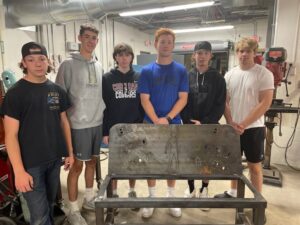 When the Corcoran High School welding shop opened in 2019, instructor Jose Ocasio knew he wanted to offer students a special final assignment. That year, and each year since, he has asked students to come up with a final project that would show their welding skills while also making a positive impact on their school community – or beyond.
When the Corcoran High School welding shop opened in 2019, instructor Jose Ocasio knew he wanted to offer students a special final assignment. That year, and each year since, he has asked students to come up with a final project that would show their welding skills while also making a positive impact on their school community – or beyond.
What initially served as a way for the welding students to learn teamwork and compromise has now grown to become a student favorite.
Austin Independent School District (AISD)
Austin Independent School District (AISD) has succeeded in developing a model for systemic social and emotional learning (SEL) for all of its 83,600 students that focuses on explicit skills instruction, SEL integration, school climate and culture, and family and community engagement. SEL coaches funded by local and federal sources are deployed throughout the system. AISD’s SEL strategic plan, first approved in 2011 and revised for 2015-2020, drives SEL implementation. Using a vertical structure, Austin started with two high schools and their feeder schools. As of 2015-16, all 130 schools in the district are implementing SEL.
Maloney High School: Building Agency & Engagement
This video from the Edutopia Schools That Work series shows student-centered learning at work at Maloney High School in Meriden Public Schools in CT. Teachers discuss their role as facilitators and detail how student-centered learning tactics are used in their classrooms. Watch the Video
Shifting Mindsets on Students at the Center
Successful implementation of the pilars of redesign involves a shift from current mindsets to the evidence-based mindsets of redesign. To download the images, right-click the image and use the “Save As” funtion.
Media Center
Features the multimedia elements of the Students at the Center driver.
One of the CSHSC’s goals is to maintain a nationwide network to share resources and experiences with other educators dedicated to redesigning the high school experience for all students.
Have a resource to share? Please share any useful resource, tool, website, etc. that you found helpful during your redesign. . .click here to share
Have a story to tell? Please share any experience, anecdote, cautionary tale you encountered during your redesign. . .click here to share

